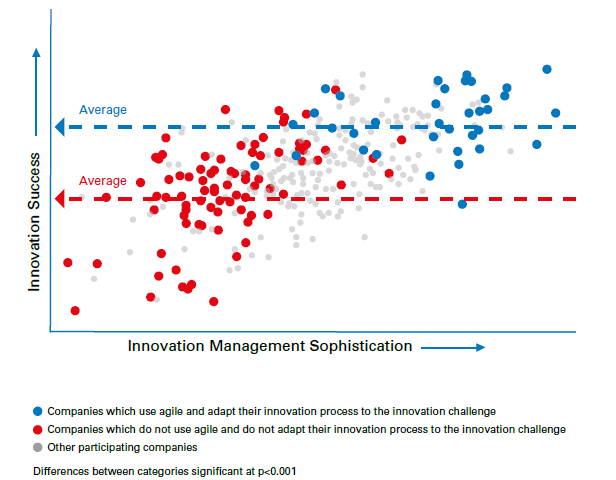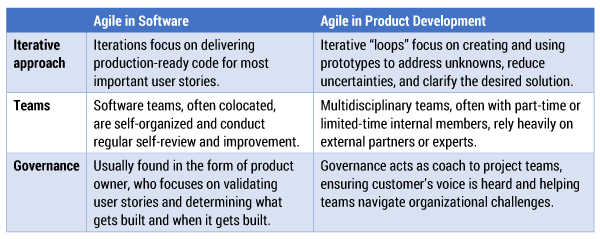For the past two decades the information technology and software world has been applying its own, highly dynamic innovation model — the Agile approach. Companies are increasingly deploying Agile alongside phase-gate processes in engineering and R&D functions outside software, with a very positive result. Our research reveals that companies that have successfully added Agile methods to their toolboxes, and tailor their innovation approaches by type of innovation, perform significantly better than those that stick to a single waterfall approach (see Figure 1).

Applying Agile Methods to Product Development
When applying an Agile approach to product development, the key Agile principles remain the same. However, certain elements take on a different twist, as shown in Table 1.

(Source: Arthur D. Little.)
Iterative Approach
The heart of the Agile approach in product development is the use of a series of rapid, iterative loops, similar to an Agile iteration for software. At the early “exploration” stages of the development lifecycle, each loop focuses on answering a key question that is determined to have a high degree of importance and uncertainty, with the aim to build a progressively clearer picture of the desired solution. Examples of loop objectives include evaluation of technical feasibility, assessment of user experience, and testing of a business model. Through these loops, the team effectively builds the user stories. A key artifact of each typically two- to four-week loop is a prototype used to test the part of the concept in question. Prototypes need to be fast and inexpensive — simple mockups, models, videos, and simulations are appropriate. This may entail using tools and methodologies new to the organization, or even collaborating with external design and prototyping firms. Prototypes are shared with a sample of customers, the key questions tested, and the learnings assessed to determine if the team can move on to a new objective for the next loop.
At the later stages of the development cycle, the loops shift their focus to “realization” and develop parts of the solution, similar to Agile in software. Loops mimic iterations and implement prioritized functionality. However, there are important constraints and considerations that lead some companies to limit their adoption of Agile methods to the early-stage activities, at least initially.
Teams
Clear roles and responsibilities and the right balance of authority and accountability are important for team success in an Agile product development environment. Teams must be nimble and the individual members comfortable with ambiguity and experimentation. In the product development environment, Agile teams are multidisciplinary groups of specialists that expand and contract depending on the current project focus.
For example, if a team is testing a business model concept, there might need to be greater involvement of people with experience and knowledge in finance, sales, and behavioral economics. This would be different from the skills needed to perform a technology-feasibility loop. To support this model, Agile product development teams are often put together with part-time or limited-time (i.e., “tour of duty”) resources. A very small “core” stays constant, and there is a designated team leader throughout the development cycle; however, that role is more analogous to a sports team captain than a hierarchical manager. The most effective teams are those that realize they do not have all the answers and embrace the involvement of external partners or experts in loop activities.
Governance
While governance is not often identified as a key element of Agile software development, it is critical within product development. In the Agile environment, governance acts less like a go/no-go decision maker and more like a coach to project teams.
Governance also serves to mitigate “organizational antibodies” that try to impede or marginalize breakthrough innovations. Loop reviews done at the end of each loop to assess whether the key question has been addressed are a discussion between project teams and their governance, using poster boards, prototypes, and other visual aids to facilitate the conversation. To enable this environment, it is important that an Agile governance group be composed of individuals who can foster a culture of experimentation and learning, a sense of urgency and agility, and a passion for helping teams jump over hurdles (versus governance being the hurdle itself). Sometimes this means the most appropriate governance team members are not the usual functional leaders, but instead people with the right mindset and knowledge, regardless of titles, and from different places across the organization. In addition, because governance is relied on for coaching more than for decision making, it creates an opportunity to include outsiders that have expertise in new or less familiar areas.
[For more from the authors on this topic, see “An Agile Path Leads to Breakthrough Product Innovation.”]





